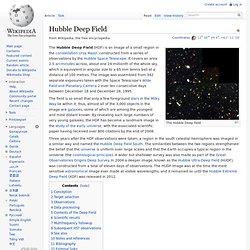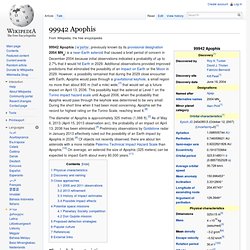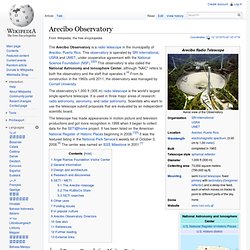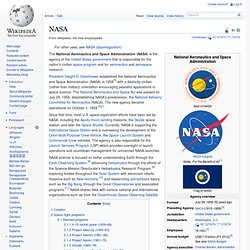

Hubble Deep Field. Coordinates: 12h 36m 49.4s, +62° 12′ 58″ The Hubble Deep Field The Hubble Deep Field (HDF) is an image of a small region in the constellation Ursa Major, constructed from a series of observations by the Hubble Space Telescope.

It covers an area 2.5 arcminutes across, about one 24-millionth of the whole sky, which is equivalent in angular size to a 65 mm tennis ball at a distance of 100 metres. The image was assembled from 342 separate exposures taken with the Space Telescope's Wide Field and Planetary Camera 2 over ten consecutive days between December 18 and December 28, 1995. The field is so small that only a few foreground stars in the Milky Way lie within it; thus, almost all of the 3,000 objects in the image are galaxies, some of which are among the youngest and most distant known. Three years after the HDF observations were taken, a region in the south celestial hemisphere was imaged in a similar way and named the Hubble Deep Field South.
Outer space. The boundaries between the Earth's surface and outer space, at the Kármán line, 100 km (62 mi) and exosphere at 690 km (430 mi).

Not to scale. There is no firm boundary where space begins. However the Kármán line, at an altitude of 100 km (62 mi) above sea level, is conventionally used as the start of outer space in space treaties and for aerospace records keeping. The framework for international space law was established by the Outer Space Treaty, which was passed by the United Nations in 1967.
This treaty precludes any claims of national sovereignty and permits all states to freely explore outer space. Discovery[edit] In ancient China, there were various schools of thought concerning the nature of the heavens, some of which bear a resemblance to the modern understanding. The original Magdeburg hemispheres (lower left) used to demonstrate Otto von Guericke's vacuum pump (right) 99942 Apophis. 99942 Apophis (/əˈpɒfɪs/, previously known by its provisional designation 2004 MN4) is a near-Earth asteroid that caused a brief period of concern in December 2004 because initial observations indicated a probability of up to 2.7% that it would hit Earth in 2029.

Additional observations provided improved predictions that eliminated the possibility of an impact on Earth or the Moon in 2029. However, a possibility remained that during the 2029 close encounter with Earth, Apophis would pass through a gravitational keyhole, a small region no more than about 800 m (half a mile) wide,[7] that would set up a future impact on April 13, 2036. This possibility kept the asteroid at Level 1 on the Torino impact hazard scale until August 2006, when the probability that Apophis would pass through the keyhole was determined to be very small. During the short time when it had been most concerning, Apophis set the record for highest rating on the Torino Scale, reaching level 4.[8] Arecibo Observatory. The observatory's 1,000 ft (305 m) radio telescope is the world's largest single-aperture telescope.

It is used in three major areas of research: radio astronomy, aeronomy, and radar astronomy. Scientists who want to use the telescope submit proposals that are evaluated by an independent scientific board. The telescope has made appearances in motion picture and television productions and got more recognition in 1999 when it began to collect data for the SETI@home project. It has been listed on the American National Register of Historic Places beginning in 2008.[1][5] It was the featured listing in the National Park Service's weekly list of October 3, 2008.[6] The center was named an IEEE Milestone in 2001.[7] Ángel Ramos Foundation Visitor Center[edit] General information[edit] The telescope has three radar transmitters, with effective isotropic radiated powers of 20 TW at 2380 MHz, 2.5 TW (pulse peak) at 430 MHz, and 300 MW at 47 MHz.
Design and architecture[edit] SETI / METI[edit] Home.
NASA. Coordinates: The National Aeronautics and Space Administration (NASA) is the agency of the United States government that is responsible for the nation's civilian space program and for aeronautics and aerospace research.

President Dwight D. Eisenhower established the National Aeronautics and Space Administration (NASA) in 1958[5] with a distinctly civilian (rather than military) orientation encouraging peaceful applications in space science. The National Aeronautics and Space Act was passed on July 29, 1958, disestablishing NASA's predecessor, the National Advisory Committee for Aeronautics (NACA). The new agency became operational on October 1, 1958.[6][7] Since that time, most U.S. space exploration efforts have been led by NASA, including the Apollo moon-landing missions, the Skylab space station, and later the Space Shuttle. Creation 1963 photo showing Dr. On July 29, 1958, Eisenhower signed the National Aeronautics and Space Act, establishing NASA. Space flight programs Manned programs. The Truth - Why Nasa Has Never Returned To The Moon Part 1. Outer Space Flight Videos & Pictures.
Space Shuttle Discovery - 360VR Images.
The Universe.